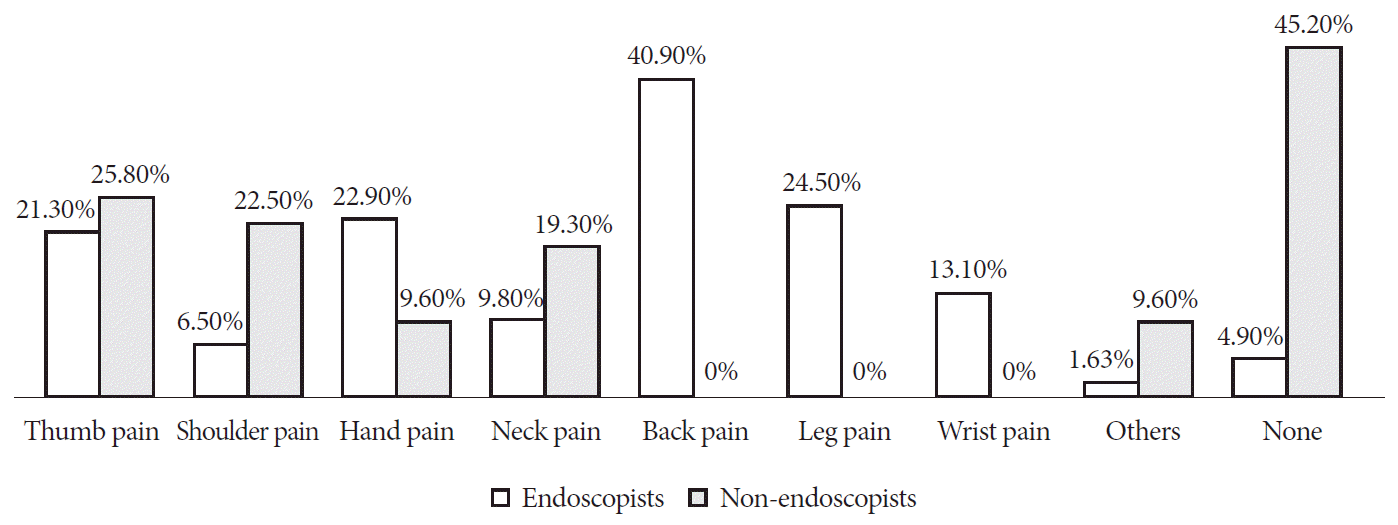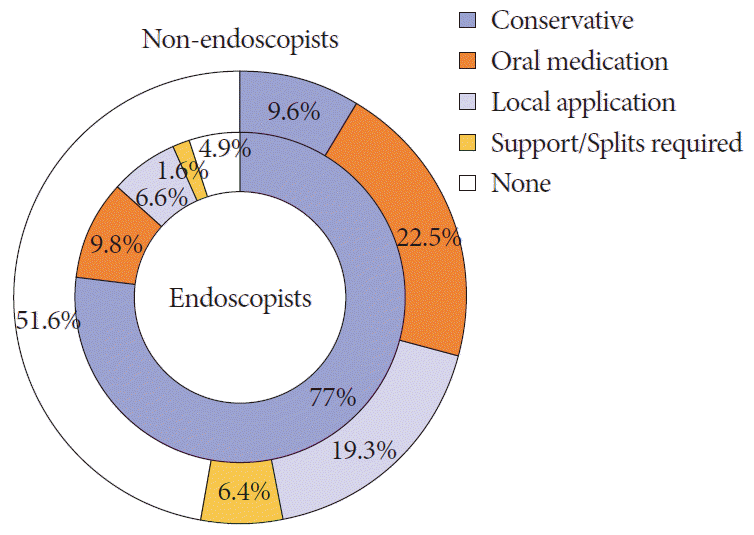INTRODUCTION
Work-related musculoskeletal (MSK) injury is the principal occupational health problem reported by the majority of health-care providers (HCPs), as routine practice poses a continuous risk. Moreover, MSK injury is an often reported complaint among endoscopists [
1-
5]. The continuous occupational load and its associated risks have been known to affect the overall quality of life and the working routine of physicians. Ergonomic injuries have been reported to occur owing to static muscle loading, repetitive movements, and inappropriate body posture during procedures [
6,
7]. Additionally, continuous repetitive procedures, lack of breaks, and personal routines and practices of HCPs double the risk of occupational injuries [
8].
Ergonomic injuries leading to pain in MSK sites (neck, low back, thumb, and hand) are frequently reported by HCPs, specifically endoscopists [
3,
4]. Previous studies have reported that the overall prevalence of these procedural injuries among endoscopists ranges from 39% to 89% [
9,
10]. Endoscopy has become the most important and frequently performed procedure in gastroenterology [
11]. Therefore, the injury risk is comparatively higher among physicians and surgeons involved in endoscopic procedures. Additionally, the disease crisis has intensified during the recent years, thus increasing procedural stress and predisposing endoscopists to occupational injuries at a high rate [
12].
Currently, work-related MSK disorders and the associated ergonomic mechanisms are points of concern for the health sector. The condition is threatening for both HCPs and patients, as it results in compromised occupational performance [
13]. MSK complaints are known to interfere with the normal work routine among endoscopists. In a previous study, approximately 84.6% endoscopists had MSK pain, which greatly affected their work routine [
14].
The demand for endoscopic procedures is expected to further increase over time [
12,
15]. Therefore, it is crucial to explore and address the ergonomic aspects of endoscopy. Although alarming outcomes have been previously reported in several international studies, very little is known about the health issues faced by most endoscopists worldwide. The basic objective of this study was to estimate the prevalence of ergonomic injuries and associated MSK pain among endoscopists in comparison with non-endoscopists. We sought to assess the risk factors and characteristics related to routine practice that contribute to the development of these ergonomic injuries.
Go to :

MATERIALS AND METHODS
A cross-sectional study was planned at a tertiary care hospital (Liaquat National Hospital [LNH]) in Karachi, Pakistan. Data were collected during a period of 6 months (August 2019 to January 2020). A total of 92 HCPs were enrolled in the study, including 61 physicians and surgeons involved in endoscopic procedures and 31 non-endoscopist physicians. The data were collected during national gastroenterology conferences across Pakistan. The study questionnaire was completed on a voluntary basis.
The study was designed according to the Declaration of Helsinki, and ethical approval was obtained from the institutional review board of LNH. Written informed consent was obtained from each HCP before enrollment in the study.
A self-administered questionnaire was designed for endoscopists, inquiring demographic details such as age, sex, weight, height, body mass index (BMI), comorbid conditions, and gastroenterology practice characteristics, such as preferred glove size and gastroenterology training. Moreover, ergonomic injuries and associated pain, including thumb, shoulder, hand, neck, back, leg, and wrist pain, were assessed in detail. Risk factors influencing ergonomic injuries and MSK pain, such as hand dominance, number of procedures performed per week, time spent performing endoscopy, participation in exercises, and cumulative duration of performing endoscopy, were also noted. However, a modified questionnaire omitting endoscopy-associated characteristics was used for non-endoscopist physicians.
The recorded data were analyzed using SPSS version 22 (IBM Corp. Chicago, IL, USA). All continuous variables, including age, weight, height, and BMI, are presented as mean±standard deviation. Qualitative variables, including age group, comorbidities, glove size, training, breaks, hand dominance, and various other characteristics associated with the practice of endoscopists, are presented as n (%). Student’s t-test was performed to evaluate differences in weight, height, and BMI between the groups, whereas the chi-square test was used to compare categorical variables. To identify the factors associated with MSK pain among endoscopists, univariate logistic regression analysis was performed, and a p-value of <0.05 was considered significant.
Go to :

DISCUSSION
Endoscopy-related technological advances have brought both constructive and destructive prospects to the science and medical fields. According to the data shared by the American Society for Gastrointestinal Endoscopy, 43% of the work routine of gastroenterologists is usually spent performing endoscopy [
12]. Endoscopic submucosal dissection, endoscopic papillary balloon dilatation, and endoscopic sphincterotomy are among the few frequently selected and performed procedures with a prolonged duration, which increases the risk of ergonomic injuries among endoscopists [
12]. These procedural technologies ensure the effective treatment of gastrointestinal diseases with the aid of detailed imaging; however, they also enhance the overall risk of endoscopists for endoscopy-related injuries, MSK pain, and prolonged exposure to radiation. Therefore, to prevent these occupational injuries, ergonomic evaluation has become a necessity. Our findings also support the hypothesis that endoscopists are more likely to develop ergonomic injuries than non-endoscopists (
p<0.00) (
Table 1), primarily owing to complex prolonged procedures and lack of necessary breaks. The overall prevalence of MSK injuries among endoscopists enrolled in the current study was 95.08%, which is consistent with several other studies [
9,
10]. Moreover, the sites of MSK pain varied among the two groups: pain in the back, leg, hand, and wrist was frequently reported among endoscopists, whereas pain in the thumb, shoulder, and neck was common among non-endoscopists. Similarly, a study conducted by Ridtitid et al. to assess the prevalence of MSK injuries among endoscopists also showed similar results, in which upper back pain was most frequently reported among endoscopists followed by thumb, low back, and hand pain [
12]. The same findings were reported by Villa et al., who observed that the common sites of injuries were the right wrist, left thumb, back, and neck [
16].
Several factors influence endoscopy-associated MSK pain. Prolonged, repetitive use or overuse of integral parts of the body during endoscopic procedures are the major influencing factors. Adjusting tip angulation controls and torquing during a colonoscopy are among the endoscope-associated maneuvers that lead to endoscopy-specific injuries, specifically colonoscopist’s thumb or de Quervain’s tenosynovitis [
7]. Evidently, frequent high-volume prolonged procedures performed per week are the leading causes of overuse injury due to repetitive movements among endoscopists [
12]. Previous studies have suggested that performing endoscopic procedures for >16 hr/week (or 20 procedures) increases the risk of MSK injuries [
10,
12]. Despite knowing the risks, endoscopists worldwide frequently exceed this threshold. A survey-based study also showed that surgeons performing >30 colonoscopies per week are at a higher risk of developing MSK injuries than those who perform <30 colonoscopies per week [
2]. In contrast, we found a higher incidence of MSK pain among endoscopists performing <20 procedures/week than among those performing >20 procedures/week. A possible explanation for this result may be that the presence of MSK pain causes these endoscopists to perform fewer procedures per week. Moreover, endoscopists performing >20 procedures/week were only 1.08 times more likely to have ergonomic injuries and MSK pain than those performing <20 procedures/week, indicating a non-significant difference with respect to procedural frequency. In addition to procedural frequency, improper positioning and prolonged therapies are other important factors leading to MSK injuries among endoscopists [
9,
10].
Although working shifts are regulated to ensure the provision of quality health-care services by the HCPs, no practical procedural limitations exist for endoscopists. Moreover, with the extensive increase in the demand for endoscopic procedures, the number of procedures performed is also increasing [
17]. Therefore, ergonomic injuries are twice as frequent among endoscopists as compared with non-endoscopists owing to increased workload [
16]. All such influencing factors can be modified by taking mini-breaks between procedures, making postural improvements, exercising, decreasing the work duration, and decreasing the frequency of procedures performed per week [
1]. Surprisingly, most of the endoscopists with gastroenterology training (96.72%) reported MSK injuries and pain. In contrast, a previous study reported very limited MSK injuries among HCPs with ergonomic training as compared with untrained endoscopists [
16]. The reason for the variation may be an inadequate training period or handling errors by endoscopists [
17].
The lack of ergonomic education evidently plays an important role in decreased practice compliance and increased ratio of injuries among HCPs performing endoscopy [
17]. The incidence rate of ergonomic injuries could be minimized through the incorporation of ergonomic principles and techniques in daily practice. Endoscopists must be trained to maintain a net neutral body position throughout the procedure, to regulate the force and energy exertion without causing strain and injuries [
18]. The back and neck are the most common pain sites reported by the endoscopists, and one of the main reasons might be height-adjustment issues concerning the monitor or procedure table [
18]. The procedural setting must be well established and adjustable according to the requirements of the endoscopist, to ease painful and prolonged performance [
19]. Minirest periods and procedural breaks are necessary to prevent overuse injuries, as they effectively facilitate the rapid recovery of fatigued muscles [
18]. Moreover, wireless medical devices must be used for monitoring purposes because they reduce the chances of accidental falls in the endoscopy unit [
9]. These preventive measures might reduce, but do not eliminate, the risk of endoscopy-related injuries and pain.
The issue is worth addressing for better clinical practice of ergonomics and better outcomes not only for qualified but also skilled HCPs (endoscopists) [
20-
22]. Although our findings indicate a higher prevalence of ergonomic injuries among endoscopists than among non-endoscopists, several study limitations need to be considered. Among the studied predictors or contributing factors, none was found to significantly contribute to ergonomic injuries and MSK pain among endoscopists. One of the major reasons might be that most of the enrolled endoscopists had an MSK injury (
n=58), whereas only three had none. Therefore, the outcomes did not significantly predict the effect. Although several international studies with large sample sizes have been published on the prevalence of MSK injuries among endoscopists [
1,
5,
12], large-scale, local descriptive studies assessing the prevalence of ergonomic injury-associated pain and its impact on occupational performance are required. Ergonomic assessment is necessary to prevent disabilities that can influence the efficiency and quality of life of endoscopists. Despite these limitations, our study explored the comparative prevalence of procedural injuries and MSK pain among endoscopists and non-endoscopists, and their preferred treatment choices. Moreover, it is one of the very few locally conducted studies involving both endoscopists and non-endoscopists, indicating a difference in the workplace environment, challenges, and risks of developing ergonomic injuries between the two groups.
In conclusion, ergonomic injuries are highly prevalent among endoscopists. Increased procedural frequency and prolonged procedural duration are more likely to cause endoscopy-related injuries. Further studies are required to investigate interventional alterations and modifications to prevent these injuries and ease the healing process among endoscopists. The ergonomic evaluation should be focused on the establishment of an adjustable procedural environment to prevent short- and long-term disabilities that can compromise the occupational performance and quality of life of endoscopists.
Go to :





 PDF
PDF Citation
Citation Print
Print





 XML Download
XML Download